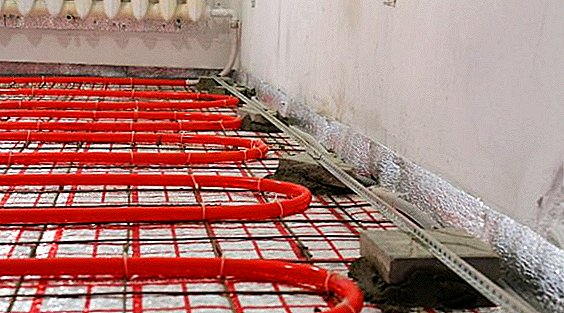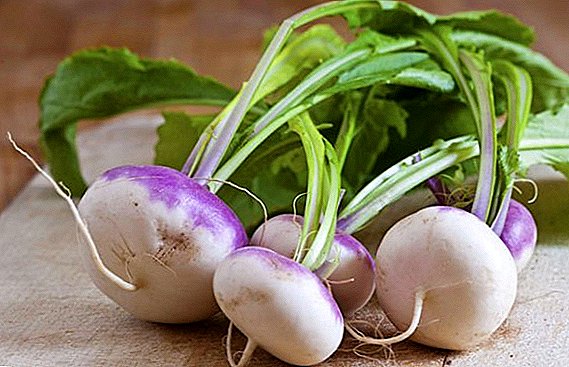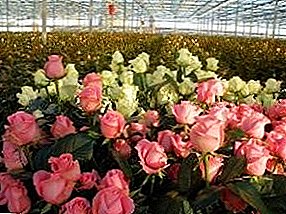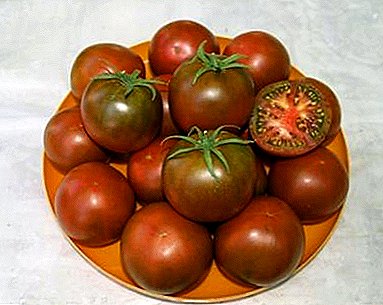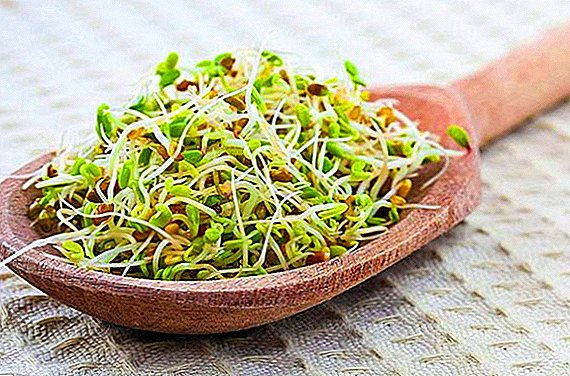 Rabbits ober look among fellow real giants. They are of interest to many rabbit breeders, who find this breed many positive features, including low price. Learn more about the standard and character of the "Germans", about the conditions of their maintenance and care.
Rabbits ober look among fellow real giants. They are of interest to many rabbit breeders, who find this breed many positive features, including low price. Learn more about the standard and character of the "Germans", about the conditions of their maintenance and care.
Breed description
Each breed has its own characteristic differences, as well as strengths and weaknesses, which should be learned before buying. Rabbits ober in the first place are remarkable for their dimensions.
Did you know? Ralph, the largest rabbit in the world, has a weight of 25 kg and a body length of 130 cm. It is a representative of the German breed ober.
Appearance and parameters
German breed standard:
- weight - 8-10 kg (females) and 9-12 kg (males);
- body length - up to 75 cm inclusive;
- coat color - black, gray, steel, gray-blue, chinchilla;
- coat length - 3 cm;
- head - large, standard shape;
- eyes - small, round;
- ear length - 15-20 cm;
- the position of the ears - V-shaped, standing;
- neck - short, wide;
- chest - wide, girth about 35-40 cm;
- tail - standard form, short;
- young stock - 8-12 individuals.

Character
These are peaceful loving creatures that are not aggressive in relation to their relatives or owners. They are not afraid of people and other pets. It is because of the calm nature that they are bred not only for obtaining valuable hides and meat, but also for decorative purposes.
However, it should be remembered that the animal is not deprived of strength, so in the event of a threat it can adequately fight off the offender. Muscular limbs and considerable weight can cause problems to an inexperienced breeder.
Familiarize yourself with the description and characteristics of the maintenance of such breeds of rabbits in the meat-and-skin direction, such as the Viennese blue and Rex.
Advantages and disadvantages
Pros:
- large output of meat;
- valuable skins of large size;
- calm character;
- good fertility;
- high profitability with proper cultivation;
- good acclimatization.

Minuses:
- high demands on the quality and composition of feed, especially in young animals;
- gigantic dimensions, due to which it is necessary to construct large cells;
- it is necessary to carry out vaccination in time, and also to give special preparations to ensure the viability of the little rabbits between the ages of the 1st and 3rd months.
Maintenance and care
For the maintenance of purebred rabbits need the appropriate conditions.
Selection and arrangement of cells
It is advisable to keep individuals of this breed precisely in cages, since they do not differ in mobility, and given the size of the rabbits, the space with a large population will require too much.
Read more about how to choose a cage for rabbits and how to make it yourself.
Cell size
Regardless of the sex of the animal, the cage must have the following parameters:
- length - 100 cm;
- width - 70 cm;
- height - 70 cm.

Materials
It is unacceptable to use cells with a mesh floor and a huge number of holes. Such coatings cause injury and frostbite during the cold season. The floor must be wooden or plastic. Ceiling and doors sheathed with galvanized mesh. The walls are best made of wood. Net coating is necessary for ventilation.
Important! You can not build monolithic cages without any holes, otherwise the rabbits will simply suffocate.
Stationary or portable
If the temperature drops to critical levels in your region during the cold season, then it makes sense to make the cage portable so as to eliminate additional costs in winter, as well as provide the animals with a comfortable temperature and lighting. Transportable cells can be installed in several tiers to save space.
Litter
Choose between straw and sawdust. Sawdust is easier to remove from the cage, but after wetting, they stick to wool. Wet straw does not stick to the animal, but it is harder to remove, and it does not have increased hydrophilicity, due to which it practically does not absorb moisture. 
Feeding trough and drinking bowl
To avoid unpleasant incidents, it is better to purchase the factory drinker, and make the feeder with your own hands. The drinker should be suitable for this breed of rabbits. Taking the design, which is designed for small decorative animals, should not be.
As for the feeder, it is better to make it out of wood or plastic. Iron is not only oxidized, but can also hurt the animal. Also in the cold, the iron trough shows itself not in the best way - when it comes into contact with frozen iron, the tongue can simply stick.
We recommend to read about how to make a drinking bowl and feeder for rabbits.
Conditions of detention
Rabbits ober quickly adapt to new conditions of detention, however, it is not recommended to arrange "stress tests", therefore pay attention to the optimal conditions for their maintenance:
- Temperature. The optimum temperature of the content is in the range of 12-18 ° C. At the same time, an increase to 23 ° С in the summer is allowed, and a decrease to 6-7 ° С in the winter. Of course, animals will withstand a negative temperature, but in this case, you should take care of the caloric intake, as well as strengthening the immune system.
- Humidity. Humidity in the cell, or in the room where the cells are located, should be in the range of 60-75%. It is extremely important to control this indicator in the summer, during heat waves, and in winter, when the temperature drops below 0 ° C.
- Air velocity It is enough to install the cells in a place where wind gusts do not exceed 30 m / s. It is important that the rabbit fur was not wet, otherwise even a small draft would cause colds.
- The sun. In addition to the fact that direct sunlight can heat the cage, turning it into a sauna in the warm season, they also negatively affect the eyesight of animals. For this reason, cells should be placed so that the sun does not fall on them at all, or the light is diffused.

Care and hygiene
The bedding is changed daily, and if there is an increased humidity, up to the fog, the procedure is repeated twice a day. In some cases, the replacement can not be carried out, but only to lay out over the old layer a new clean litter, but you should not take it as a rule, especially in the warm season.
Important! It is necessary to control the percentage of toxic substances in the air. If animals are not provided with good ventilation (observed when kept indoors), poisoning by hydrogen sulfide or ammonia may occur.
Clean the water bowl and feeder daily. It is not recommended to use strong chemicals, but if the herd is sick with something, this option is appropriate. Complete disinfection of equipment and cells with all equipment is carried out at least once a month.
In the cold season, the rules do not change, so it is important to think over everything in advance so that the rabbits do not get sick. If a livestock has become infected with an infectious disease, complete disinfection should be done every 2 weeks, or even more often. 
Vaccination
Young animals should be vaccinated at the age of 1-2 months to prevent the occurrence of common diseases. Only healthy individuals are vaccinated so that serious complications do not develop.
A consultation with a veterinarian is required, which will determine which vaccine is needed, as well as conduct the entire procedure. Prick drugs yourself is prohibited.
Diet and feeding rates
It depends on the preparation of the correct diet more than on care, so it is important not only to purchase food in time, but also to calculate the norms by age.
Find out what you can’t feed rabbits, what kind of vegetables and fruits you can give to rabbits, and also whether you can give rabbits fish oil, burdocks, wormwood, nettles, bran, dill, peas, corn, cereals, bread, plain and dry milk.
Summer menu:
- greens (valuable wild-growing herbs, tops of leguminous plants, kale);
- good quality hay;
- root vegetables (carrots, potatoes, cabbage, beets, pumpkin, zucchini).

Winter menu:
- thin branches of trees;
- compound feeds for rabbit meat breeds;
- quality hay;
- meat and bone meal;
- roots.
Remember that the norms are significantly different from those that apply to other, smaller in mass and size of rocks. To calculate the required amount of feed, it is necessary to observe consumption for several days, providing food in large quantities.
Did you know? Rabbits can jump 1.5 meters in height and reach speeds of up to 55 km / h. At the same time, the maximum possible speed of a person’s run is 44 km / h.
Such an "experiment" will not affect body fat, and you will be able to calculate the necessary volumes and number of feed units.
Video: feeding rabbits in winter
Case and okrol
The case is held when the female reaches the age of 4-5 months, and her weight will be equal to or exceed 2.5 kg. If the weight is below the specified rate, it is better to hold it for fattening. It is also worth remembering that if the female does not have mating upon reaching the required age, she will begin to grow fat, which in the end will not allow for healthy, viable offspring.
The female is placed in the cage of the male. First you need to feed the animals so that they want to mate and not eat. Then the whole process takes place in a matter of hours. You can make sure of success by the behavior of the male, who lies on his back and makes loud sounds.
It is possible to ascertain pregnancy already on the 12th day after mating. To do this, the bunny is soothed, after which he is placed on his back and gently palpable the stomach. To the touch you can feel the small oval lumps, which are the embryo.
It will be useful for you to read about when the rabbit can be allowed to be mated, how long it lasts and how to determine the rabbit suckling, when it is possible to set the rabbit away from the rabbit, and also how to determine the sex of the rabbit.
Juveniles appear a month after mating. Rabbits are born blind, deaf and without wool. Their weight must be at least 45 g, otherwise this is considered a developmental defect.
The first month of rabbits contain together with the "mother", providing a comfortable environment (no drafts, constant temperature, optimal light day). Young animals are deposited one month after birth, when their weight already reaches 0.5 kg.  The rabbit rations add more foods that contain proteins, and the caloric content is increased by 1.5-2 times, so that the animal can provide the offspring with everything necessary.
The rabbit rations add more foods that contain proteins, and the caloric content is increased by 1.5-2 times, so that the animal can provide the offspring with everything necessary.
Feed small rabbits start from 3 weeks of life, when they, in addition to breast milk, can already eat foods intended for adults. Root vegetables are given in a crushed form, as well as a wet mash. Carefully monitor the quality of the feed and its temperature.
Important! New products must be introduced gradually. If digestive upset occurs, then - follows at the time to exclude what caused the negative reaction of the gastrointestinal tract.
The German Ober is a highly productive breed, which in skillful hands will allow to get a big profit due to the delivery of meat and skins. However, it is worth remembering that these rabbits are very voracious, because of what they are slaughtered at 4-5 months of life. Keeping as a pet is extremely expensive, which is also worth remembering.



